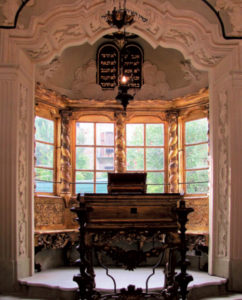MIRAMARE From Mantua to Jerusalem
Is there a strong connection of art and thought, beyond feelings, between Jerusalem and Jewish Italy? In its new book “Mantova e Gerusalemme, arte e cultura ebraica nella città dei Gonzaga” (“Mantua and Jerusalem, Jewish Art and Culture in the City of the Gonzagas”) Andreina Contessa gives definitive proof of it and goes through five centuries of history, tying a thread of art, faith and beauty designed by following the tracks of Jewish history. The book sketches out a brief history of Judaism in Mantua through its artistic production and its old sacred objects, most of which are today scattered around the world. Following the peregrination between Mantua and Jerusalem of one of the oldest holy arks, the author tells the story of the Jewish community of Mantua and opens unexpected horizons on the Jewish artistic commission in Italy, in particular regarding women. Following the tracks of the donor of this wonderful and unique ark, it is possible to revisit the stories of all the Mantuan arks that are now kept in Jerusalem. The art historian explains: “In the spring of 1543, a woman donated to the Sinagoga Grande (Schola Grande) of Mantua a magnificent holy ark and two monumental cathedrae. The holy ark was destined to keep the Torah scrolls and would become the heart of the synagogue liturgy; the two cathedrae would welcome the important people of the city. Both the ark and the cathedrae were made of finely carved, sculpted and gilded wood, with an elegant and precious racemes and acanthus leaves decoration. An inscription on one of the cathedrae indicated that the donor was Consilia Norsa, daughter of Samuele (Shemuel) Da Pisa and wife of Isacco Norsa from Ferrara. These beautiful liturgical objects made it through time and history and are still today well preserved. The inscribed dedication is, in fact, still clearly legible. Following the incredible story of the Sinagoga Grande of Mantua, the ark and cathedrae were brought to Sermide, where they remained for many centuries, until 1955, when they were taken to Jerusalem. There, they were destined to become one of the most important pieces of the permanent exhibition of the Umberto Nahon Museum of Italian Jewish Art.” In this book, that further extends previous studies, a brief history of Judaism in Mantua is published for the first time. The history of Mantuan Judaism is told through its artistic production, its sacred objects, that are nowadays in large part scattered around the world, and a selection of documents and posters that show some interesting glimpses of Jewish life throughout time. By following the peregrination from Mantua to Jerusalem of its most representative element, the holy ark of 1543, the intention is to unravel the thread of the history of one of the most important Jewish community of that time in Europe, and to open new horizons in the study of the Jewish artistic commission in Italy, in particular the one regarding women. To do so, the way in which Renaissance women entrusted their legacy to devotional gifts is analysed. Moreover, in this book the author proposes a revised analysis of the holy ark and its context and, where possible, recalls the stories of all the Mantuan arks that are kept in Jerusalem and in Israel. Professor Shlomo Simonsohn of the University of Tel Aviv comments: “Finally an academic who wants to take back the ark from oblivion and understand its secrets. The ark was discarded from the Mantuan Jewish community and handed over to the community in Sermide, then it was discarded again, and it was finally saved by the late Umberto Nahon. Nahon took it to Jerusalem in the 1950s. There, the ark was renovated and an appropriate place was found for it (at least for now) in the museum named after the very same Nahon. Undoubtedly, the donor was Sara-Consi(g)lia, daughter of Samuele- Simone Da Pisa, wife of Isacco Norsa, and sister of the well-known Vitale (Yechiel) Nissim Da Pisa. The artisan who created the ark, Jewish or Christian, is still unknown, and he will probably stay that way.” It’s only the beginning of an exciting story, in which the history of art becomes active and fascinating evidence and through the specific case of a glorious community, that of Mantua, it testifies to the huge creative heritage that Italian Judaism was able to donate.
Translation by Sara Volpe, student at the Advanced School for Interpreters and Translators of Trieste University, intern at the newspaper office of the Union of the Italian Jewish Communities.

